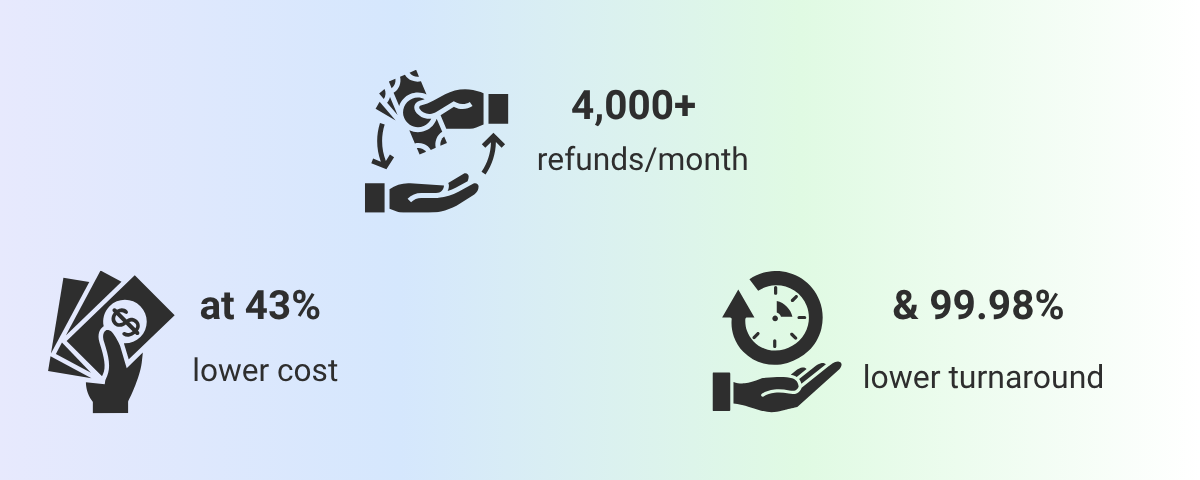AI Agent handling 4,000+ Refunds/month with 43% Lower Cost

Overview
Managing refunds at scale had become an expensive and error-prone operation for one of the most process-focused e-commerce companies in the U.S. With over 4,000 refund requests coming in every month across multiple brands and storefronts, the team relied on full-time agents to manually review, validate, and process each one. The system worked - but just barely. It was slow, resource-heavy, and exposed to human error.
While the company had made significant strides in streamlining customer support through automation, the refund workflow remained untouched - largely because it was seen as too sensitive, too complex, or simply too niche to automate safely.
That changed when SigmaMind AI built an AI agent designed specifically to handle this repetitive, high-volume task - without requiring a single human touchpoint.
The Problem
Every refund request followed the same rigid process: a customer would reach out their helpdesk to request a refund, a support agent would manually pull up the order in Shopify, validate the details, check the request against the refund policy, process the refund, and update their internal system for tracking purposes.
There were three major costs embedded in this flow:
- Time - Each refund took time to process manually, often leading to backlogs and delays of up to 72 hours.
- Cost - Up to 4 full-time support agents were dedicated to handling this task. During high volume periods they would need more agents resulting in cost escalations. .
- Risk - Even small errors - like a mistyped order ID or refunding the wrong item - led to financial loss and a bad customer experience.
The Solution
SigmaMind AI deployed an AI agent that completely took over the refund process - from intake to completing the refund.
The new AI agent flow looks like this when a customer reaches out with a refund request -
- AI agent pulls customer and order info from Shopify
- Validates it against the refund policy
- Auto-populates most of the refund details in their internal system (used for tracking purposes)
- Processes the refund
- Enters the refund details in their internal system again for reconciliation by the accounts department.
The result was a low-friction experience on both ends - customer and ops - without adding complexity to the existing tech stack.
No humans were needed in the loop. No logic had to be reconfigured. SigmaMind AI simply plugged into the existing helpdesk and Shopify stack - and started doing the work.
Outcome & Impact
- Led to 43% cost saving
- Reduced turnaround time improved from 2–3 days to under 60 seconds resulting in superior customer experience.
- Achieve zero processing errors since launch resulting in elimination of financial risk.
The Broader Strategy
This automation initiative builds on the client’s larger AI-first customer support strategy. In a previous engagement, SigmaMind AI had helped automate 70% of the company’s support tickets - cutting first response times by 71% and reducing support costs by more than 50%. The refund automation agent was designed with the same principles in mind: high-impact, low-touch, infrastructure-level efficiency.
While customer-facing AI often gets the spotlight, it’s backend automation like this that often drives the clearest ROI. No extra tools, no interface redesign - just seamless execution where it’s needed most.
“Refunds were eating up way too much time - and time is money in our world. What SigmaMind AI delivered wasn’t just a script or chatbot. It was a backend operator that just gets the job done, perfectly, every single time. We’ve saved thousands already - and our team can finally focus on actual customer issues.”
- Director of Customer Experience
Conclusion
When automation is treated as infrastructure - not just interface - the results are transformative. For this e-commerce leader, SigmaMind AI didn’t just automate a workflow. It eliminated an entire category of operational load, unlocking both efficiency and scale.
Refunds are often seen as cost centers. This case proves they don’t have to be.



